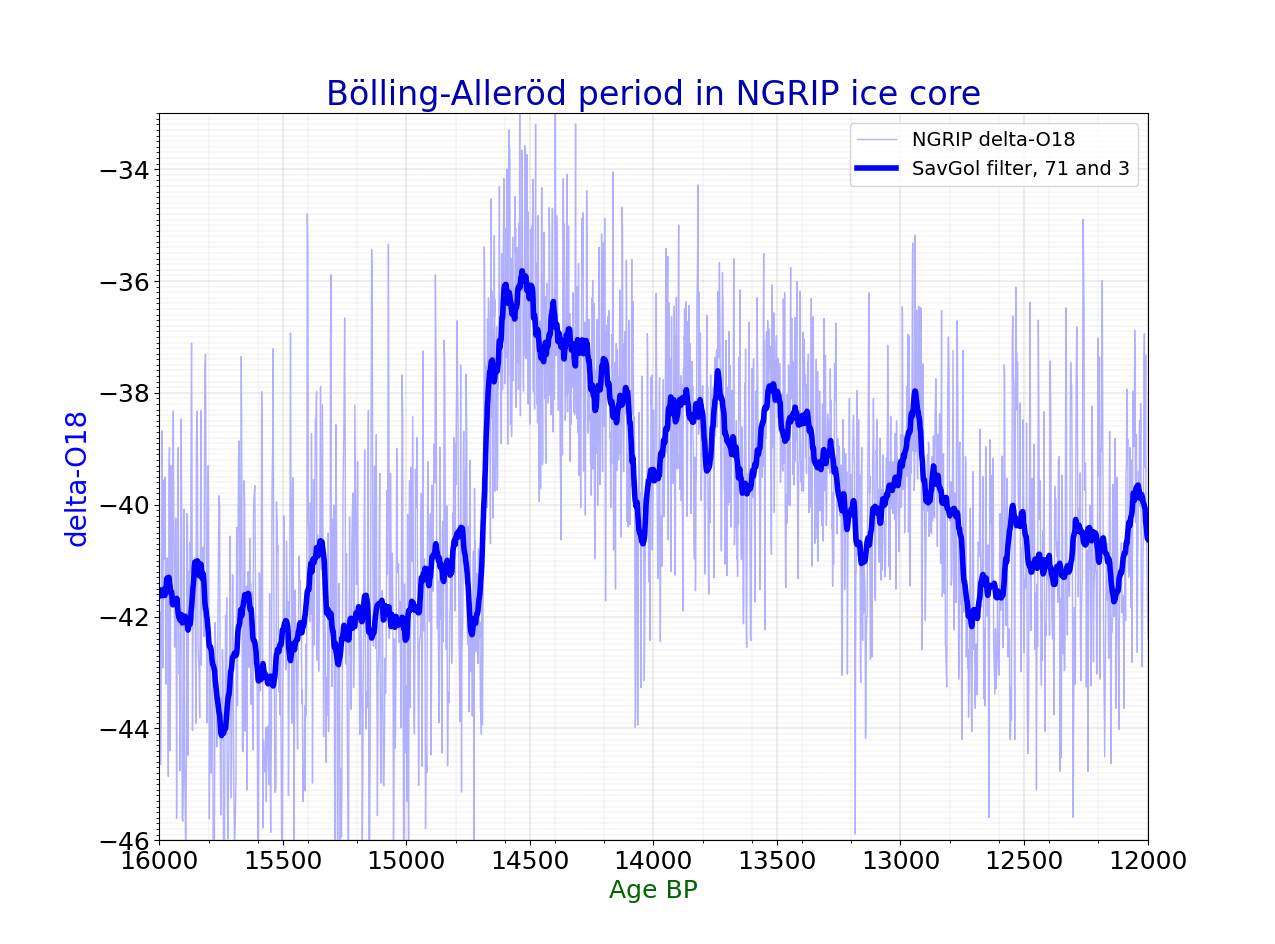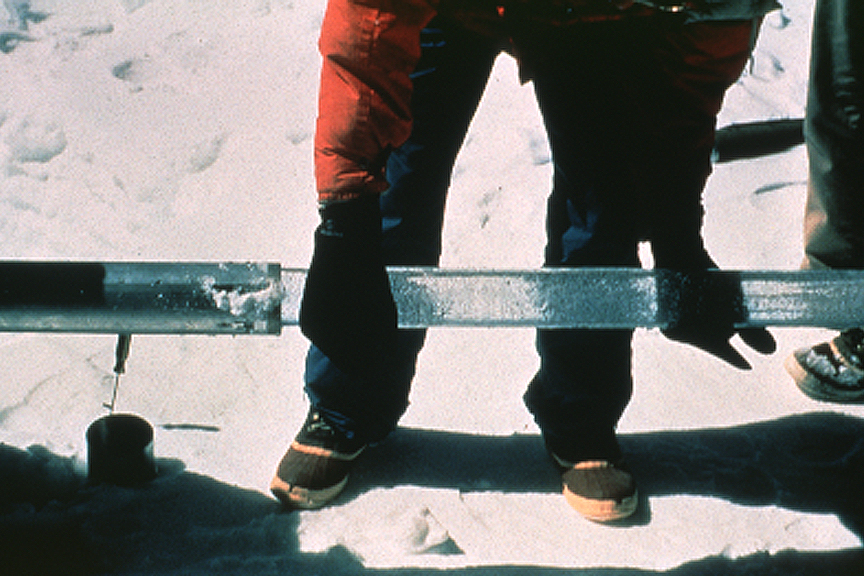|
Interstadial
Stadials and interstadials are phases dividing the Quaternary period, or the last 2.6 million years. Stadials are periods of colder climate, and interstadials are periods of warmer climate. Each Quaternary climate phase has been assigned with a marine isotope stage (MIS) number, which describes the alternation between warmer and cooler temperatures, as measured by oxygen isotope data. Stadials have even MIS numbers, and interstadials have odd MIS numbers. The current Holocene interstadial is MIS 1, and the Last Glacial Maximum stadial is MIS 2. Marine isotope stages are sometimes subdivided into stadials and interstadials by minor climate fluctuations within the overall stadial or interstadial, which are indicated by letters. The odd-numbered interstadial MIS 5, also known as the Sangamonian interglacial, contains two periods of relative cooling, and so is subdivided into three interstadials (5a, 5c, 5e) and two stadials (5b, 5d). A stadial isotope stage like MIS 6 wou ... [...More Info...] [...Related Items...] OR: [Wikipedia] [Google] [Baidu] |
Bølling–Allerød Interstadial
The Bølling–Allerød Interstadial (), also called the Late Glacial Interstadial (LGI), was an interstadial period which occurred from 14,690 to years Before Present, during the final stages of the Last Glacial Period. It was defined by abrupt warming in the Northern Hemisphere, and a corresponding cooling in the Southern Hemisphere, as well as a period of major ice sheet collapse and corresponding sea level rise known as Meltwater pulse 1A. This period was named after two sites in Denmark where paleoclimate evidence for it was first found, in the form of vegetation fossils that could have only survived during a comparatively warm period in Northern Europe. It is also referred to as Interstadial 1 or Dansgaard–Oeschger event 1. This interstadial followed the Oldest Dryas period, which lasted from ~18,000 to 14,700 BP. While Oldest Dryas was still significantly colder than the current epoch, the Holocene, globally it was a period of warming from the very cold Last Glacial Maxi ... [...More Info...] [...Related Items...] OR: [Wikipedia] [Google] [Baidu] |
Younger Dryas
The Younger Dryas (YD, Greenland Stadial GS-1) was a period in Earth's geologic history that occurred circa 12,900 to 11,700 years Before Present (BP). It is primarily known for the sudden or "abrupt" cooling in the Northern Hemisphere, when the North Atlantic Ocean cooled and annual air temperatures decreased by ~ over North America, in Europe and up to in Greenland, in a few decades. Cooling in Greenland was particularly rapid, taking place over just 3 years or less. At the same time, the Southern Hemisphere experienced warming. This period ended as rapidly as it began, with dramatic warming over ~50 years, the transition from the glacial Pleistocene epoch into the current Holocene. The Younger Dryas onset was not fully synchronized; in the tropics, the cooling was spread out over several centuries, and the same was true of the early-Holocene warming. Even in the Northern Hemisphere, temperature change was highly seasonal, with much colder winters, cooler springs, yet no cha ... [...More Info...] [...Related Items...] OR: [Wikipedia] [Google] [Baidu] |
Interglacial
An interglacial period (or alternatively interglacial, interglaciation) is a geological interval of warmer global average temperature lasting thousands of years that separates consecutive glacial periods within an ice age. The current Holocene interglacial began at the end of the Pleistocene, about 11,700 years ago. Pleistocene During the 2.5 million years of the Pleistocene, numerous glacials, or significant advances of continental ice sheets, in North America and Europe, occurred at intervals of approximately 40,000 to 100,000 years. The long glacial periods were separated by more temperate and shorter interglacials. During interglacials, such as the present one, the climate warms and the tundra recedes polewards following the ice sheets. Forests return to areas that once supported tundra vegetation. Interglacials are identified on land or in shallow epicontinental seas by their paleontology. Floral and faunal remains of species pointing to temperate climate and indicating a ... [...More Info...] [...Related Items...] OR: [Wikipedia] [Google] [Baidu] |
Marine Isotope Stage 5
Marine Isotope Stage 5 or MIS 5 is a marine isotope stage in the geologic temperature record, between 130,000 and 80,000 years ago. Sub-stage MIS 5e corresponds to the Last Interglacial, also called the Eemian (in Europe) or Sangamonian (in North America), the last major interglacial period before the Holocene, which extends to the present day. Interglacial periods which occurred during the Pleistocene are investigated to better understand present and future climate variability. Thus, the present interglacial, the Holocene, is compared with MIS 5 or the interglacials of Marine Isotope Stage 11. Substages MIS 5, is divided into substages, divided alphabetically or with a numeric system for referring to "horizons" (events rather than periods), with MIS 5.5 representing the peak point of MIS 5e, and 5.51, 5.52 etc. representing the peaks and troughs of the record at a still more detailed level. Marine Isotope Stage (MIS) 5e Marine Isotope Stage (MIS) 5e, called the Eemian ... [...More Info...] [...Related Items...] OR: [Wikipedia] [Google] [Baidu] |
Older Dryas
The Older Dryas was a stadial (cold) period between the Bølling and Allerød interstadials (warmer phases), about 14,000 years Before Present, towards the end of the Pleistocene. Its date range is not well defined, with estimates varying by 400 years, but its duration is agreed to have been around two centuries. The gradual warming since the Last Glacial Maximum (27,000 to 24,000 years BP) has been interrupted by two cold spells: the Older Dryas and the Younger Dryas (c. 12,900–11,650 BP). In northern Scotland, the glaciers were thicker and deeper during the Older Dryas than the succeeding Younger Dryas, and there is no evidence of human occupation of Britain. In Northwestern Europe there was also an earlier Oldest Dryas (18.5–17 ka BP 15–14 ka BP). The Dryas are named after an indicator genus, the Arctic and Alpine plant '' Dryas octopetala'', the remains of which are found in higher concentrations in deposits from colder periods. The Older Dryas was a variable cold, ... [...More Info...] [...Related Items...] OR: [Wikipedia] [Google] [Baidu] |
Bølling Oscillation
Bølling can refer to: * Bølling lake, Denmark – a shallow lake in central Jutland, after which the following are named: *The Bølling Oscillation or Interstadial – a warm phase during the last phase of the Weichsel glaciation in Europe; often referred to as a part of the Bølling–Allerød period, which includes the Older Dryas stadial between them. *The Bølling Phase – a biostratigraphic subdivision during the early post-glacial period in Europe {{disambiguation ... [...More Info...] [...Related Items...] OR: [Wikipedia] [Google] [Baidu] |
Oldest Dryas
The Oldest Dryas is a biostratigraphic subdivision layer corresponding to a relatively abrupt climatic cooling event, or stadial, which occurred during the last glacial retreat. The time period to which the layer corresponds is poorly defined and varies between regions, but it is generally dated as starting at 18.5–17 thousand years ( ka) before present (BP) and ending 15–14 ka BP. As with the Younger and Older ''Dryas'' events, the stratigraphic layer is marked by abundance of the pollen and other remains of ''Dryas octopetala'', an indicator species that colonizes arctic-alpine regions. The termination of the Oldest Dryas is marked by an abrupt oxygen isotope excursion, which has been observed at many sites in the Alps that correspond to this interval of time. In the Alps, the Oldest Dryas corresponds to the Gschnitz stadial of the Würm glaciation. The term was originally defined specifically for terrestrial records in the region of Scandinavia, but has come to be us ... [...More Info...] [...Related Items...] OR: [Wikipedia] [Google] [Baidu] |
Glacial Period
A glacial period (alternatively glacial or glaciation) is an interval of time (thousands of years) within an ice age that is marked by colder temperatures and glacier advances. Interglacials, on the other hand, are periods of warmer climate between glacial periods. The Last Glacial Period ended about 15,000 years ago. The Holocene is the current interglacial. A time with no glaciers on Earth is considered a Greenhouse and icehouse Earth, greenhouse climate state. Quaternary Period Within the Quaternary, which started about 2.6 million years before present, there have been a number of glacials and interglacials. At least eight glacial cycles have occurred in the last 740,000 years alone. Changes in atmospheric and associated radiative forcing were among the primary drivers of globally cold glacial and warm interglacial climates, with changes in ocean physical circulation, biological productivity and seawater acid-base chemistry likely causing most of the recorded changes Penul ... [...More Info...] [...Related Items...] OR: [Wikipedia] [Google] [Baidu] |
Ice Core
An ice core is a core sample that is typically removed from an ice sheet or a high mountain glacier A glacier (; or ) is a persistent body of dense ice, a form of rock, that is constantly moving downhill under its own weight. A glacier forms where the accumulation of snow exceeds its ablation over many years, often centuries. It acquires .... Since the ice forms from the incremental buildup of annual layers of snow, lower layers are older than upper ones, and an ice core contains ice formed over a range of years. Cores are Ice drilling, drilled with hand Auger (drill), augers (for shallow holes) or powered drills; they can reach depths of over two miles (3.2 km), and contain ice up to 800,000 years old. The physical properties of the ice and of material trapped in it can be used to reconstruct the climate over the age range of the core. The proportions of different oxygen and hydrogen isotopes provide information about Paleothermometer, ancient temperatures, a ... [...More Info...] [...Related Items...] OR: [Wikipedia] [Google] [Baidu] |
Snowball Earth
The Snowball Earth is a historical geology, geohistorical hypothesis that proposes that during one or more of Earth's greenhouse and icehouse Earth, icehouse climates, the planet's planetary surface, surface became nearly entirely freezing, frozen with no liquid oceanic or surface water exposed to the atmosphere of Earth, atmosphere. The most academically mentioned period of such a global ice age is believed to have occurred some time before 650 myr#Usage, mya during the Cryogenian period, which included at least two large glacial periods, the Sturtian glaciation, Sturtian and Marinoan glaciations. Proponents of the hypothesis argue that it best explains sedimentary deposition (geology), deposits that are generally believed to be of glacial origin at tropical palaeolatitudes and other enigmatic features in the geological record. Opponents of the hypothesis contest the geological evidence for global glaciation and the Geophysics, geophysical feasibility of an ice- or slush-cover ... [...More Info...] [...Related Items...] OR: [Wikipedia] [Google] [Baidu] |
Greenhouse And Icehouse Earth
Throughout Earth's climate history (Paleoclimate) its climate has fluctuated between two primary states: greenhouse and icehouse Earth. Both climate states last for millions of years and should not be confused with the much smaller glacial and interglacial periods, which occur as alternating phases within an icehouse period (known as an ice age) and tend to last less than one million years. There are five known icehouse periods in Earth's climate history, namely the Huronian, Cryogenian, Andean-Saharan (also known as Early Paleozoic), Late Paleozoic and Late Cenozoic glaciations. The main factors involved in changes of the paleoclimate are believed to be the concentration of atmospheric greenhouse gases such as carbon dioxide () and less importantly methane (), changes in Earth's orbit, long-term changes in the solar constant, and oceanic and orogenic changes from tectonic plate dynamics. Greenhouse and icehouse periods have played key roles in the evolution of life on Ea ... [...More Info...] [...Related Items...] OR: [Wikipedia] [Google] [Baidu] |





